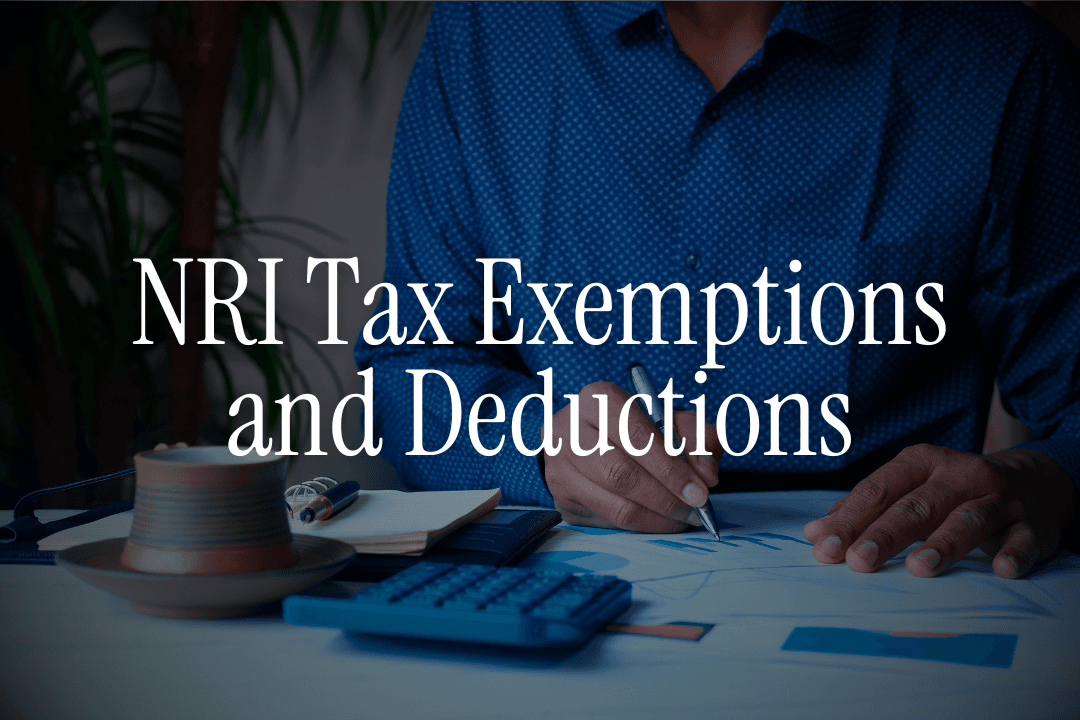
Here's a number that will surprise you: The average NRI we work with saves ₹2.8 lakhs annually in Indian taxes just by claiming the right exemptions and deductions.
Yet, 73% of NRIs either don't know about these benefits or claim them incorrectly.
Last week, Mehta from Dubai discovered he'd been overpaying ₹85,000 every year for the past five years. He had ₹15 lakhs in Indian FDs, owned rental property in Mumbai, and paid health insurance for his parents - but his CA never told him about NRE account benefits, Section 80D deductions, or the new regime's higher exemption limits.
That's ₹4.25 lakhs of his hard-earned money, gone forever.
If you're an NRI paying taxes in India, you're probably leaving money on the table.
The Indian tax system offers numerous legitimate ways to reduce your liability, but the rules are complex, constantly changing, and poorly understood even by many tax professionals.
This isn't about aggressive tax planning or risky schemes. These are government-approved benefits specifically designed to encourage NRI investment and compliance. You just need to know which ones apply to your situation and how to claim them correctly.
By the end of this comprehensive guide, you'll understand every major tax exemption and deduction available to NRIs, how they stack up against what residents get, and the exact documentation needed to claim them.
You'll know which regime - old or new -saves you the most money based on your specific income and investment pattern.
Let's start with the big picture, then dive into strategies that could save you lakhs.
The NRI Tax Advantage: What You Get That Residents Don't
Most NRIs don't realize they actually have some unique tax advantages over residents. Here's the complete picture:
Special NRI-Only Benefits
NRE & FCNR Account Interest:
- Completely tax-free in India
- No limit on amount or tenure
- Residents can't access this benefit
Also Read - NRE vs NRO vs FCNR
Capital Gains Flexibility:
- Can claim exemptions under Section 54/54F like residents
- DTAA benefits for foreign tax credit
- Special rules for repatriation
Deemed Income Protection:
- Only Indian-source income taxable
- Foreign salary/business income exempt (for true NRIs)
- No global income disclosure required
What You Share with Residents
Chapter VIA Deductions:
- Section 80C: Up to ₹1.5 lakh
- Section 80D: Up to ₹75,000 (₹50,000 + ₹25,000 parents)
- Section 80E: Education loan interest (unlimited - for old tax regime choosers)
- Section 80G: Charitable donations
Capital Gains Exemptions:
- Section 54: Residential property reinvestment
- Section 54F: Any asset → residential property
- Section 54EC: Investment in specified bonds
The Numbers That Matter
Here's how these benefits translate to real savings for a typical NRI:
Income Source | Tax Without Benefits | Tax With Benefits | Annual Savings |
|---|---|---|---|
₹50L NRE FDs @ 7% | ₹1.05L (30% on interest) | ₹0 (exempt) | ₹1.05L |
Health insurance (₹48K) | ₹9.6K tax burden | ₹0 (80D deduction) | ₹9.6K |
ELSS investment (₹1.5L) | ₹30K tax burden | ₹0 (80C deduction) | ₹30K |
Total Annual Savings | ₹1.65L |
👉 Tip: The combination of NRE account benefits and traditional deductions often saves NRIs more than residents with similar incomes.
Understanding the New vs Old Tax Regime for NRIs
This is where most NRIs get confused. The choice between regimes can make a ₹50,000+ difference annually.
Old Tax Regime Benefits (For NRIs)
Higher Deduction Opportunities:
- All Section 80C benefits: ₹1.5 lakh
- Section 80D health insurance: Up to ₹75,000
- Section 80E education loans: Unlimited
- Home loan interest: ₹2 lakh under Section 24(b)
Best For:
- NRIs with significant eligible investments
- Those paying health insurance premiums
- Home loan borrowers
- High deduction scenarios (₹3+ lakh total)
New Tax Regime Benefits (For NRIs)
Higher Basic Exemption:
- ₹4 lakh (increased from ₹3 lakh in FY 2025-26)
- Lower tax slabs across the board
- Simplified compliance
Available Deductions (Limited):
- Standard deduction: ₹75,000 for salaried
- Employer NPS contribution: 80CCD(2)
- Home loan interest for let-out property: Unlimited
Best For:
- Simple income structures
- Low deduction eligibility
- Higher income without major investments
Real Calculation: Which Regime Saves You More?
Case Study: Priya from UAE
- Indian salary: ₹12 lakhs
- NRE FD interest: ₹2 lakhs (tax-free in both regimes)
- ELSS investment: ₹1.5 lakhs
- Health insurance: ₹48,000
- Home loan interest: ₹1.2 lakhs
Old Regime Calculation:
- Taxable income: ₹12L - ₹2.5L - ₹1.5L - ₹48K - ₹1.2L = ₹6.77L
- Tax liability: ₹67,700
New Regime Calculation:
- Taxable income: ₹12L - ₹4L - ₹75K = ₹7.25L
- Tax liability: ₹87,500
Winner: Old regime saves ₹19,800 annually
👉 Tip: Calculate both regimes annually. Your optimal choice can change based on income, investments, and life events.
Also Read - Old Tax Regime Vs New Tax Regime - What Should NRIs Choose
Section 80C: Your ₹1.5 Lakh Shield Against Taxes
Section 80C is the workhorse of NRI tax planning. Here's how to maximize every rupee:
What Qualifies for NRIs
Life Insurance Premiums:
- Own policy, spouse, or children
- Premium ≤ 10% of sum assured (for policies after April 2012)
- No upper limit within ₹1.5L overall cap
ELSS Mutual Funds:
- Best growth potential within 80C
- 3-year lock-in period
- Available to NRIs through major fund houses
Home Loan Principal Repayment:
- For Indian property only
- Both self-occupied and let-out property
- Stamp duty and registration charges also qualify
Children's Tuition Fees:
- Maximum two children
- Any Indian educational institution
- Full-time education only
Other Qualifying Investments:
- PPF (not available for new NRI accounts post-2003)
- NSC, ULIP, NABARD bonds
- Sukanya Samriddhi Yojana (if eligible)
Smart 80C Planning for NRIs
The Optimal Mix Strategy: Instead of putting all ₹1.5 lakhs in one instrument:
- ₹50,000 in ELSS (for growth potential)
- ₹60,000 in life insurance (for protection)
- ₹40,000 in home loan principal (forced saving)
Timing Your Investments:
- ELSS: Invest monthly through SIP for rupee cost averaging
- Insurance: Pay annually to avoid service charges
- Home loan: Prepay in March to maximize current year deduction
Common Mistakes to Avoid:
- Buying insurance just for tax saving (over-insurance)
- Ignoring ELSS because of lock-in (best long-term returns)
- Not coordinating with spouse's investments
Real Example: Sharma from London has ₹15 lakh Indian income and invests:
- ₹80,000 ELSS SIP (₹6,667 monthly)
- ₹40,000 life insurance premium
- ₹30,000 home loan principal
His Section 80C tax saving: ₹1.5 lakh deduction = ₹30,000 actual tax saved (20% tax bracket).
Section 80D: Health Insurance Benefits for NRI Families
This is often the most underutilized deduction among NRIs, yet it can save ₹15,000+ annually.
Coverage Limits for NRIs
Family Member | Age | Maximum Deduction |
|---|---|---|
Self + Spouse + Dependent Children | Any | ₹25,000 |
Parents (Indian Resident) | Below 60 | ₹25,000 |
Parents (Indian Resident) | Above 60 | ₹50,000 |
Maximum Total | ₹75,000 |
What Qualifies
Eligible Policies:
- Health insurance for self, spouse, dependent children
- Health insurance for resident Indian parents
- Preventive health check-ups (₹5,000 sub-limit)
- Medical expenses for senior citizen parents (if not insured)
Payment Requirements:
- Must be paid through banking channels (no cash)
- Digital payments preferred
- Maintain all receipts and policy documents
Strategic Health Insurance Planning
The Family Coverage Strategy: If you're earning ₹15 lakhs and in 20% tax bracket:
- Family floater (₹25,000 premium): ₹5,000 tax saved
- Parents policy (₹40,000 premium): ₹8,000 tax saved
- Total annual benefit: ₹13,000
Preventive Health Check-up Hack:
- ₹5,000 can be claimed even without insurance
- Covers health check-ups, vaccinations
- Useful for NRIs visiting India annually
Common Claiming Errors:
- Paying premiums for NRI siblings (not eligible)
- Cash payments (disqualifies the deduction)
- Wrong age classification for parents
👉 Tip: If parents are above 60, their separate policy gives you ₹50,000 deduction vs ₹25,000 for family floater covering them.
The NRE/FCNR Account Tax Goldmine
This is where NRIs have a massive advantage over residents. Understanding these benefits can save lakhs annually.
Completely Tax-Free Income
NRE Account Benefits:
- Interest completely exempt from Indian tax
- No TDS deduction at source
- Principal and interest both repatriable
- No limit on amount or tenure
FCNR Account Benefits:
- Interest exempt from Indian tax
- Currency risk protection
- Minimum deposit: Usually $1,000 or equivalent
- Tenure: 1-5 years typically
The Compounding Advantage
Example Calculation: ₹1 crore in NRE FDs @ 7% for 5 years:
- With tax (if it were NRO): ₹4.26 crore final value
- Without tax (NRE benefit): ₹4.74 crore final value
- Tax savings over 5 years: ₹48 lakhs
Converting NRO to NRE: Smart Strategies
When It Makes Sense:
- When you have confirmed NRI status
- Interest income exceeds ₹10,000 annually
- Planning long-term wealth accumulation
How to Convert:
- Submit NRI documents to bank
- Provide overseas address proof
- Complete KYC update
- Transfer funds through banking channels
Documentation Required:
- Valid passport with visa
- Overseas address proof
- Employment/business proof abroad
- Form A2 for large transfers
👉 Tip: Even ₹5 lakh in NRE FDs saves ₹10,500 annually compared to taxable NRO FDs (assuming 30% tax rate).
Capital Gains Exemptions: The Property Investor's Toolkit
NRIs selling property or investments in India have powerful exemption tools available:
Section 54: House-to-House Exemption
How It Works:
- Sell residential property → reinvest in new residential property
- Complete exemption if entire capital gain reinvested
- Proportional exemption if partial reinvestment
Timeline Requirements:
- Purchase new house: 1 year before to 2 years after sale
- Construct new house: Within 3 years of sale
- Hold new property: At least 3 years (or exemption reversed)
Real Example: Gupta from UAE sells Mumbai apartment:
- Sale price: ₹2 crores
- Purchase price (2010): ₹60 lakhs
- Capital gain: ₹1.4 crores
- Tax liability without exemption: ₹17.5 lakhs (12.5% LTCG)
- With Section 54 (buying ₹2 crore house): ₹0 tax
- Tax saved: ₹17.5 lakhs
Section 54F: Any Asset to House Conversion
Broader Scope:
- Sell any capital asset (shares, gold, bonds) → buy residential house
- Not limited to property-to-property transactions
- Same timeline and holding requirements as Section 54
Strategic Use Case:
- NRI with large equity portfolios can use this for house purchase
- Especially valuable for equity gains exceeding ₹1.25 lakh LTCG exemption limit
Section 54EC: Bond Investment Route
Quick Facts:
- Invest capital gains in specified bonds within 6 months
- Complete exemption up to ₹50 lakh investment
- 5-year lock-in period for bonds
- Currently available bonds: NHAI, REC, PFC
When to Use:
- Don't want to buy another property
- Need liquidity after 5 years
- Capital gains between ₹10-50 lakhs range
Other Important Tax Exemptions for NRIs
Section 80E: Education Loan Interest
Unlimited Deduction Benefits:
- Interest on education loans for higher studies
- Available for 8 years from first repayment year
- Covers loans for self, spouse, children, or dependents
- No upper limit on deduction amount
Strategic Planning:
- Time loan repayments with high-income years
- Consider prepayment strategy for optimal tax benefit
- Useful for NRIs funding children's Indian education
Section 80G: Charitable Contributions
Qualifying Donations:
- PM CARES Fund: 100% deduction
- National Defense Fund: 100% deduction
- Recognized charitable institutions: 50% deduction
- Political parties: 100% deduction (but with conditions)
NRI-Specific Considerations:
- Donations must be to Indian registered entities
- FCRA-compliant organizations for international transfers
- Maintain proper receipts with PAN details
Long-Term Capital Gains Exemption
₹1.25 Lakh Annual Exemption:
- Available on equity shares and equity mutual funds
- Gains beyond this taxed at 12.5%
- Can be used year after year (not cumulative)
Strategic Harvesting:
- Book profits up to ₹1.25 lakh annually tax-free
- Reinvest to step up cost basis
- Useful for portfolio rebalancing without tax impact
RNOR Benefits: The Returning NRI Advantage
If you're planning to return to India, RNOR (Resident but Not Ordinarily Resident) status offers unique benefits:
Two-Year Grace Period
Foreign Income Benefits:
- Foreign salary/business income: Tax-free in India
- Foreign asset income: Tax-free in India
- NRE/FCNR interest: Continues to be tax-free
- Gradual transition to full Indian tax residency
RNOR Qualification:
- Been NRI for 9 out of 10 preceding years, OR
- Been in India ≤ 729 days in preceding 7 years
Strategic RNOR Planning
Timing Your Return:
- Plan return in low Indian income year
- Maximize foreign income during RNOR period
- Convert investments to tax-efficient structures
Investment Restructuring:
- Keep foreign investments active during RNOR period
- Convert NRO to NRE before losing NRI status
- Plan capital gains transactions strategically
Documentation: Getting Your Claims Right
Proper documentation is crucial for claiming exemptions. Here's what you need:
Essential Documents by Section
Section 80C Claims:
- Insurance policy documents and payment receipts
- ELSS investment confirmations and bank statements
- Home loan statements showing principal component
- School fee receipts for children's education
Section 80D Claims:
- Health insurance policy copies
- Premium payment receipts (digital payments only)
- Age proof for family members
- Medical check-up bills and receipts
NRE/FCNR Benefits:
- Account opening acknowledgments
- Interest certificates from banks
- NRI status documents updated with banks
- Repatriation certificates for large amounts
Common Documentation Mistakes
Missing Critical Details:
- Insurance receipts without policy numbers
- Fee receipts without educational institution details
- Health check-up bills without diagnostic center details
- Bank statements without clear interest breakdowns
Wrong Payment Methods:
- Cash payments for any deduction claims
- Third-party payments for personal deductions
- Undated or unclear payment receipts
- Missing digital payment confirmations
Outdated Documents:
- Expired NRI status certificates
- Old passport copies for bank records
- Previous year's TRC for current year claims
- Invalid or closed account details
Recent Changes and Updates (2025)
New Tax Regime Enhancements
Increased Basic Exemption:
- Raised to ₹4 lakh from ₹3 lakh (FY 2025-26)
- Standard deduction increased to ₹75,000
- Some Chapter VIA deductions may be restored
LTCG Tax Changes:
- Rate reduced to 12.5% from 20%
- Indexation benefit removed for most assets
- ₹1.25 lakh exemption continues for equity
NRI-Specific Updates
Enhanced DTAA Benefits:
- Improved information exchange
- Faster TRC processing in some countries
- Better coordination for foreign tax credits
Account Operation Changes:
- Easier NRE/NRO conversions
- Digital KYC updates for overseas residents
- Improved repatriation documentation process
ITR Filing Changes
New Disclosure Requirements:
- Enhanced details needed for deduction claims
- Policy numbers mandatory for insurance deductions
- Loan account details required for 80C home loan claims
- Stricter validation of 80D age criteria
Strategic Tax Planning for Different NRI Profiles
High-Income NRIs (₹25L+ Indian Income)
Optimal Strategy:
- Stick with old regime if deductions >₹3 lakhs
- Maximize Section 80C through ELSS and insurance
- Consider Section 54EC for capital gains management
- Plan timing of asset sales and purchases
Advanced Techniques:
- Stagger capital gains across financial years
- Use spouse's deduction limits optimally
- Time property purchases with high gain years
- Coordinate with foreign tax planning
Middle-Income NRIs (₹8-25L Indian Income)
Balanced Approach:
- Calculate both regimes annually
- Focus on NRE account benefits
- Basic 80C through ELSS and insurance
- Health insurance for family protection and tax benefit
Key Focus Areas:
- Regime switching based on yearly situation
- Building systematic investment discipline
- Emergency fund in tax-free NRE accounts
- Regular review of deduction eligibility
Conservative NRIs (₹8L Indian Income)
Simple Strategy:
- New regime usually better due to higher exemption
- Focus on NRE account interest exemption
- Basic health insurance for 80D benefits
- Minimal complexity in tax planning
Sector-Specific Strategies
IT Professionals:
- ELSS investments for 80C
- Health insurance covering overseas treatment
- Education loan planning for skill upgrades
- Stock option timing considerations
Healthcare Workers:
- Professional indemnity insurance considerations
- Medical equipment purchases for Indian practice
- Continuing education expense planning
- Home loan for clinic/hospital property
Business Owners:
- Business loan interest vs personal home loan
- Capital asset planning for business transfers
- Multiple property investment strategies
- Partnership vs company structure implications
Common Mistakes That Cost NRIs Thousands
Mistake 1: Wrong Regime Choice
The Error: Defaulting to new regime without calculation
Cost: ₹50,000-₹1,50,000 annually for high-deduction NRIs
Solution: Annual regime comparison using actual numbers
Mistake 2: Incomplete 80C Utilization
The Error: Using only ₹50,000 of ₹1.5 lakh limit
Cost: ₹20,000 in unnecessary taxes (20% bracket)
Solution: Systematic investment planning across eligible instruments
Mistake 3: Ignoring Health Insurance Benefits
The Error: No health insurance for Indian family members
Cost: ₹15,000 in lost tax benefits plus health risk exposure
Solution: Comprehensive family health coverage planning
Mistake 4: Suboptimal Account Structure
The Error: Keeping large amounts in taxable NRO FDs
Cost: 30% annual tax on interest income
Solution: Strategic NRE account utilization
Mistake 5: Poor Capital Gains Planning
The Error: Selling assets without exemption planning
Cost: 12.5-20% tax on entire gain amount
Solution: Section 54/54F/54EC strategic implementation
Tools and Resources for NRI Tax Planning
Government Resources
Official Portals:
- Income Tax Department: incometaxindia.gov.in
- Tax regime calculator on IT portal
- DTAA treaty documents database
- Official ITR forms and instructions
Calculation Tools
Essential Calculators:
- Tax regime comparison calculator
- Section 80C optimization planner
- Capital gains exemption calculator
- NRE vs NRO interest comparison tool
Professional Tools:
- ITR software with NRI-specific validations
- Investment planning spreadsheets
- Documentation checklists
- Compliance calendar templates
Belong's NRI Resources
Specialized Guidance:
Building Your Personal Tax Strategy
Annual Planning Process
January-March:
- Review previous year's tax efficiency
- Plan current year's deduction investments
- Update insurance and investment amounts
- Assess regime choice for upcoming year
April-June:
- Implement planned investments
- Update bank KYC and documentation
- Review and optimize existing portfolio
- Plan any property or asset transactions
July-September:
- Monitor investment performance
- Adjust strategy based on income changes
- Plan year-end tax-saving investments
- Prepare documentation for ITR filing
Long-Term Considerations
Life Stage Planning:
- Young NRIs: Focus on growth + basic deductions
- Family stage: Health insurance + children's education
- Senior NRIs: Capital gains management + health focus
- Return planning: RNOR optimization strategy
Also Read - How to File Income Tax Return in India as an NRI
Wealth Accumulation Strategy:
- Tax-free compounding through NRE accounts
- Strategic use of exemptions for wealth building
- Regular portfolio rebalancing using tax benefits
- Estate planning with tax optimization
The Action Plan: Your Next Steps
Immediate Actions (This Month)
Calculate Your Optimal Regime
- List all eligible deductions
- Compare tax under both regimes
- Make regime choice for current year
Optimize Account Structure
- Review NRO vs NRE allocation
- Convert accounts if beneficial
- Update KYC documentation
Audit Current Investments
- Check 80C utilization
- Review insurance coverage
- Assess capital gains planning needs
Medium-Term Planning (Next 6 Months)
Systematic Investment Setup
- ELSS SIP for 80C benefits
- Regular premium payment scheduling
- Health insurance renewal planning
Documentation Organization
- Create digital filing system
- Set up receipt collection process
- Establish annual review schedule
Long-Term Strategy (Annual Review)
Comprehensive Planning Review
- Assess changing tax laws
- Adjust strategy based on life changes
- Optimize for upcoming major transactions
Professional Consultation
- Complex situations requiring expert guidance
- Multi-country tax coordination
- Estate and succession planning integration
Also Read - Tax Implications of Investments for NRIs in India Complete Guide
Key Takeaways
Here's everything you now know about NRI tax exemptions and deductions:
The Big Picture: NRIs have access to most deductions that residents enjoy, plus unique benefits like NRE/FCNR tax exemptions. Strategic use of these benefits can save ₹2-5 lakhs annually for middle to high-income NRIs.
Regime Choice Matters: The old vs new regime decision can impact your tax liability by ₹50,000+ annually. High-deduction NRIs often benefit from the old regime, while simple income structures favor the new regime.
Account Structure is Critical: NRE and FCNR accounts offer completely tax-free interest, often worth more than traditional tax-saving investments. This is the biggest advantage NRIs have over residents.
Capital Gains Planning: Sections 54, 54F, and 54EC provide powerful tools to defer or eliminate capital gains taxes on property and investment sales. Strategic timing can save lakhs on large transactions.
Documentation Drives Success: Proper documentation is essential for claiming benefits. Digital payments, correct forms, and timely submissions determine whether you get your deductions or face rejections.
Planning Beats Reaction: Annual tax planning, regime optimization, and strategic investment timing deliver far better results than last-minute tax-saving purchases.
Professional Help for Complex Situations: While basic planning can be DIY, complex situations involving multiple countries, large transactions, or business income benefit from professional guidance.
Also Read - Best NRI Fixed Deposit Accounts India Complete Tax & Rate Guide
The most successful NRIs we work with treat tax planning as an ongoing process, not a March deadline scramble. They maximize their unique advantages, stay informed about changes, and make strategic decisions throughout the year.
Your tax exemptions and deductions are legal money in your pocket. The question isn't whether you should claim them - it's how strategically you optimize them for your specific situation.
Don't leave your money on the table. Start with the immediate actions in your action plan, and build from there.
Join our NRI community WhatsApp group to get advice from other successful NRIs.
Sources: Income Tax Department of India, HDFC Life, Bajaj Finserv, HSBC India, ICICI Bank, IDFC FIRST Bank
This guide covers major tax provisions as of 2025. Tax laws change frequently and individual situations vary significantly. Always consult qualified tax professionals familiar with both Indian and your resident country's laws before making investment or tax planning decisions.




